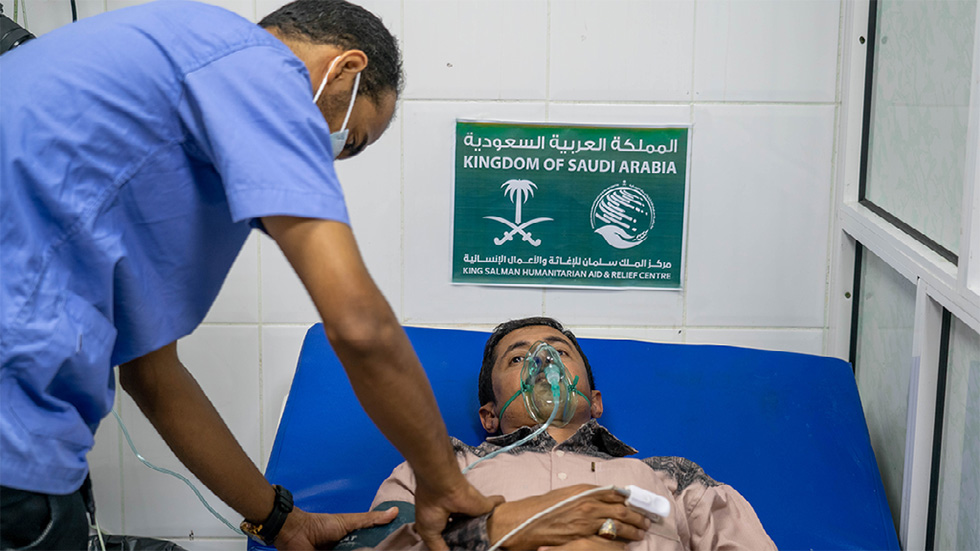Lifeline of hope: health care in remote areas is enhanced by the KSrelief oxygen station

28 January 2024 – Nestled in the remote reaches of Bayhan district, Shaheed Al Defaiaah Hospital is a vital element of health care provision. In this isolated part of Yemen, this hospital provides access to medical care at reasonable prices, making it a lifeline to local communities.
The hospital plays a crucial role in facilitating the urgent transfer of patients who require complex and specialized treatment while ensuring that others in need receive timely and proper care.
 Given this critical mission, the support from King Salman Humanitarian Aid and Relief Centre (KSrelief) to establish an oxygen station at the hospital benefits not only the district but also the entire Shabwa governorate . The new station ensures a steady and reliable supply of oxygen to those in desperate need.
Given this critical mission, the support from King Salman Humanitarian Aid and Relief Centre (KSrelief) to establish an oxygen station at the hospital benefits not only the district but also the entire Shabwa governorate . The new station ensures a steady and reliable supply of oxygen to those in desperate need.
"The oxygen station replaced the previous practice of transporting oxygen from nearby districts, providing a more sustainable solution for Bayhan district,” said Emergency Department Manager Dr Mohammed Tawfiq Sheikh Al-Fatmi.
From struggle to hope: Al-Akhdar Hadi’s encounter with the oxygen station
In Alghariqa village in Bayhan, Mr Al-Akhdar Saleh Ahmed Hadi , a resilient 30-year-old asthma patient, vividly shares the uphill battle his family has faced due to the relentless grip of asthma. “Asthma appears to run in my family,” he said. He went on to describe the severe breathlessness that he endures when exposed to dust or the smoke from burned incense.
Both Mr Hadi and his mother are asthma patients and require oxygen supply from time to time. Unfortunately, this essential resource has often been unavailable owing to oxygen shortages in the area. These frequent shortages have left patients like Mr Hadi and his mother gasping for air during distressing asthma attacks.
 “Asthma is a relentless adversary for my family,” Mr Hadi stressed. “My mum and I need a supply every now and then – especially during dusty weather – which we sometimes could not find.”
“Asthma is a relentless adversary for my family,” Mr Hadi stressed. “My mum and I need a supply every now and then – especially during dusty weather – which we sometimes could not find.”
The setting up of an oxygen station in the area, with the aim of supporting all patients like Mr Hadi, has transformed the situation. Oxygen availability has increased, lessening the struggles faced by both patients and health workers, especially in critical asthma and stroke cases . “The station alleviated many of the struggles for health care providers and patients, as oxygen is mostly used and is a crucial medical supply, and the presence of the station alleviated the concerns we used to have before,” said Dr Al-Fatmi .
“I’m glad that we will finally be able to find the oxygen when needed the most. I feel more secure for myself and my family,” concluded Mr Hadi.
The oxygen station project surpasses mere oxygen provision – it signifies a commitment to make oxygen available to all , whenever it is needed. The community has felt the positive effects of the project, confirming that the project has exceeded expectations in all the geographic areas it has managed to reach. The improved accessibility to oxygen has emerged as a lifeline for vulnerable families in dire need of this essential service.
Breathing life into Yemen: impact of the Five Oxygen Stations life-saving initiative
Yemen’s struggle: a need for oxygen amid the crisis
Due to the crisis in Yemen has left many health facilities grappling with urgent needs that must be met to be able to provide essential health services. These needs include electricity and fuel: a shortage affecting both the public and private sectors and disrupting oxygen production is making an already critical situation worse.
Medical oxygen is a life-saving and therapeutic treatment for various medical conditions. These include both acute and chronic diseases such as respiratory diseases, cardiovascular diseases, COVID-19 and pneumonia, along with critical complications across all age groups. Demand for oxygen is growing, yet in many countries, including Yemen, delivering the much-needed quantity to the health system remains a significant challenge.
Oxygen is indispensable in Yemen’s clinics and hospitals. It is necessary for surgeries, maternal and child care and the treatment of medical conditions such as asthma and pneumonia. Epidemics have strained Yemen’s medical oxygen supply, and ongoing conflict has left hospitals and clinics without easy access to fresh oxygen supplies, worsening the challenges they face.
KSrelief’s vital role: transforming health care in Yemen with the Five Oxygen Stations initiative
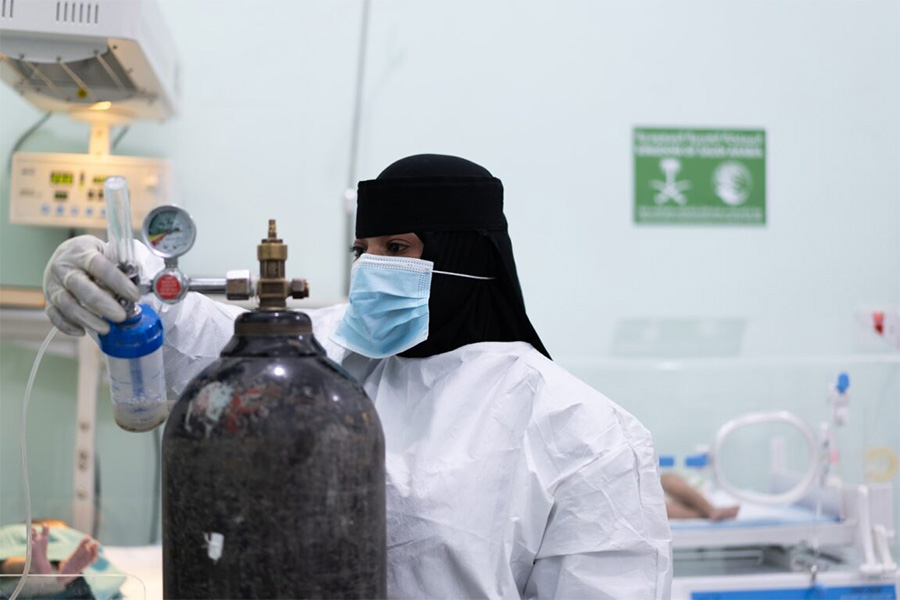 With generous support from King Salman Humanitarian Aid and Relief Centre (KSrelief), WHO has implemented a transformative project, installing 5 oxygen stations across Abyan, Hadhramaut, Al Maharah, Marib and Shabwah governorates in Yemen. These stations, each set up in a major hospital, address the critical need for a sustainable medical oxygen source in remote health facilities.
With generous support from King Salman Humanitarian Aid and Relief Centre (KSrelief), WHO has implemented a transformative project, installing 5 oxygen stations across Abyan, Hadhramaut, Al Maharah, Marib and Shabwah governorates in Yemen. These stations, each set up in a major hospital, address the critical need for a sustainable medical oxygen source in remote health facilities.
This strategic move not only cuts costs but also fortifies health facilities, stabilizing operational capacities and ensuring a reliable source of medical oxygen. The impact extends beyond basic care to also benefit intensive care units, nursery units, emergency units, operating theatres and other treatment units.
The project has surpassed expectations, touching the lives of 235 943 beneficiaries, including 85 454 people who received life-changing oxygen therapy. This initiative has gone beyond its goals, significantly enhancing the health care landscape and health and well-being in the 5 governorates.
Life breathes easier: Dr Al-Zubaidi unveils the impactful journey of KSrelief’s oxygen station in Tarim district
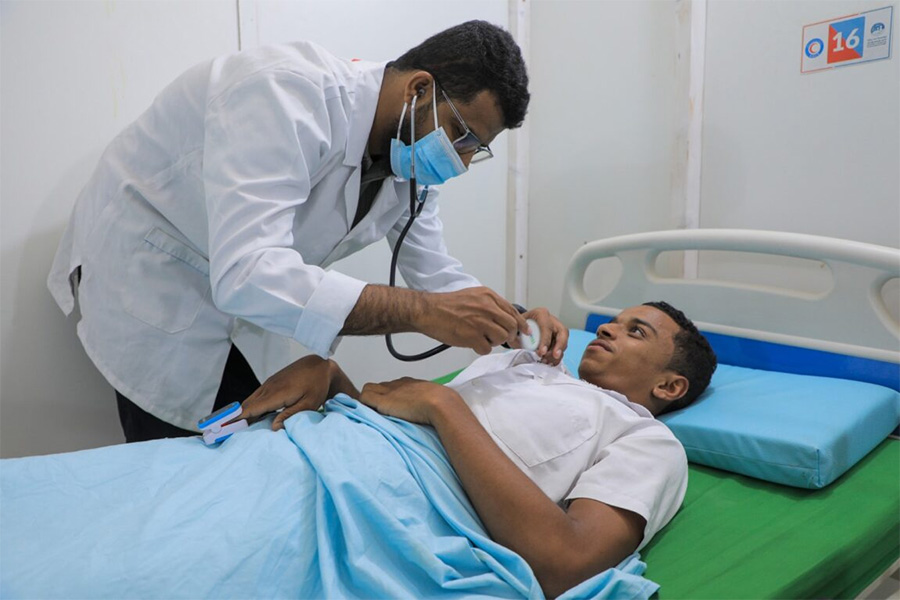 WDr Mohyeldin Al-Zubaidi, who holds a degree in general medicine and surgery, is a dedicated general practitioner in the emergency room of Tarim Hospital, Hadhramaut. Day after day, he tirelessly attends to urgent and non-urgent cases, providing crucial medical interventions to those in need.
WDr Mohyeldin Al-Zubaidi, who holds a degree in general medicine and surgery, is a dedicated general practitioner in the emergency room of Tarim Hospital, Hadhramaut. Day after day, he tirelessly attends to urgent and non-urgent cases, providing crucial medical interventions to those in need.
The COVID-19 emergency posed an unprecedented challenge for the hospital and its staff. An absence of the necessary interventions, especially oxygen-related treatments, compelled patient transfers, causing immense distress to families and caregivers. Dr Al-Zubaidi and his colleagues ardently advocate for the full range of services in all hospitals to ease the burden on patients and their loved ones.
“This hospital has a remarkable impact on the community,” remarked Dr Al-Zubaidi. “The Tarim district has witnessed a significant improvement in health care access due to the installation of a cutting edge oxygen station at the hospital. People can now easily access the oxygen supply they need.”
Dr Al-Zubaidi’s team cares for a diverse range of people, including society’s most vulnerable. The hospital supports those in critical need, such as elderly people, newborns and infants suffering from heart and lung disorders or congenital heart problems. The oxygen station has transformed their well-being, breathing new life into their existence.
“In the past, patients had to travel long distances to different districts in search of oxygen, risking fatalities and encountering additional health complications due to the distance and lack of available services,” explained Dr Al-Zubaidi. “However, with the establishment of the oxygen station in the Tarim district, it has become a cornerstone for the area, a testament to the transformative power of compassion and a single initiative on an entire community.”
Epidemiological situation in Yemen: diphtheria
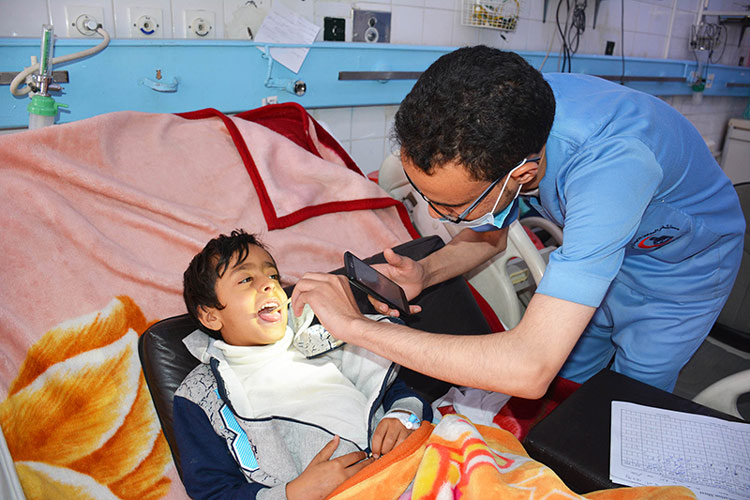
16 November 2023, Sana’a, Yemen – Reports of diphtheria cases in Yemen (to 14 October 2023) are 57% higher than in 2021 and 2022. Cases have risen gradually since 2021, with a significant increase noted in 2023.
So far this year, 1671 suspected diphtheria cases have been reported in the country, with 109 associated deaths, compared with 1283 cases reported in the whole of 2022. Diphtheria is typically a winter illness, so the increase in cases noted from June to September 2023 marks a change from the usual seasonal pattern.
In response to the current increase in cases, WHO is working to supply Yemen’s Ministry of Public Health and Population with an urgent quantity of 2200 vials of diphtheria antitoxin, which will be distributed to the most affected areas. Due to the complexities of the Yemen situation, however, only 220 vials have been delivered to date, whereas the global shortage of diphtheria antitoxin affects its availability and increases prices.
“The 2200 doses that WHO has secured are only enough to treat 300 severe patients, which is inadequate to address the issue,” said Dr Arturo Pesigan, WHO Representative in Yemen. “It is projected that in 2024 multiple ongoing and growing outbreaks of vaccine-preventable diseases – including diphtheria – will persist, with the proportion of unvaccinated, or zero-dose, children reaching 28%. The funding shortage and issues of inaccessibility are affecting the health and lives of vulnerable people in Yemen.”
Among children in Yemen, there has been a significant drop in immunization rates and a correlated increase in cases of vaccine-preventable diseases. This decline in coverage continues to worsen owing to economic deterioration, low incomes, displacement, and overcrowded living conditions in camps, coupled with an overstretched health system and chronic funding shortage. Millions of children cannot be reached by routine immunization activities, and suspected cases of vaccine-preventable diseases have risen to unprecedented levels.
WHO continues to monitor and analyse outbreak trends and reported cases on a weekly basis, to ensure a full understanding of the epidemiological situation for various circulating outbreaks.
About diphtheria
Diphtheria is an infection caused by the bacterium Corynebacterium diphtheriae. Signs and symptoms range from mild to severe and often come on gradually, with a higher mortality rate among unvaccinated younger children. In severe cases, the bacteria produce a poison (toxin) that causes a thick grey or white patch at the back of the throat that can block the airway, making it hard to breathe or swallow.
The toxin may also get into the bloodstream, causing complications that may include inflammation and damage of the heart muscle, inflammation of nerves, kidney problems and bleeding problems. The damaged heart muscle may result in an abnormal heart rate and inflammation of the nerves may result in paralysis.
For more information on Yemen’s health situation, visit: Yemen Health Emergency
For more information on diphtheria, visit: Diphtheria Questions and Answers
Media contacts: WHO Yemen Communications,
About WHO
Since 1948, the World Health Organization (WHO) has been the United Nations agency dedicated to advancing health for all, so that everyone, everywhere can attain the highest level of health. WHO leads global efforts to expand universal health coverage, direct and coordinate the world’s responses to health emergencies and connect nations, partners and people to promote health, keep the world safe and serve the vulnerable.
Yemen struck by Tropical Cyclone Tej as its health system struggles to cope
 An image of the impact of Tropical Cyclone Tej on Huswain District, Al Mahrah Governorate, Yemen, taken on 24 October 2023. Photo credit: Emergency operations centre, Al Mahrah Governorate29 October 2023, Sana’a, Yemen – Tropical Cyclone Tej hit Yemen’s eastern coast areas of Al Mahrah Governorate and Socotra archipelago on 23 and 24 October 2023. As of 24 October, the storm moved towards the eastern regions of Hadramout Governorate. The affected areas experienced heavy and torrential rains that led to major damage to infrastructure including health facilities, roads, telecommunications lines and electricity.
An image of the impact of Tropical Cyclone Tej on Huswain District, Al Mahrah Governorate, Yemen, taken on 24 October 2023. Photo credit: Emergency operations centre, Al Mahrah Governorate29 October 2023, Sana’a, Yemen – Tropical Cyclone Tej hit Yemen’s eastern coast areas of Al Mahrah Governorate and Socotra archipelago on 23 and 24 October 2023. As of 24 October, the storm moved towards the eastern regions of Hadramout Governorate. The affected areas experienced heavy and torrential rains that led to major damage to infrastructure including health facilities, roads, telecommunications lines and electricity.
In Al Mahrah Governorate, severe weather conditions and damage to roads hindered access to rescue stranded people and protect lives. Information about the situation remains limited but efforts are under way by local authorities and partners to access affected areas. Yemen’s health system is already overburdened with the direct impact of 9 years of conflict. Health facilities lack specialized doctors, medical supplies, and adequate infrastructure to address the most basic needs.
According to the United Nations Office for the Coordination of Humanitarian Affairs (OCHA), a local media outlet has reported at least 7 deaths, with more than 1000 people displaced. The same source attested that the authorities had declared a state of emergency and temporarily shut schools in Al Mahrah Governorate.
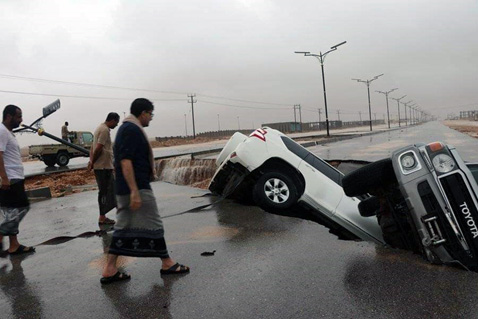 An image of the damage wreaked by Tropical Cyclone Tej on Huswain District, Al Mahrah Governorate, Yemen, taken on 24 October 2023. Photo credit: Emergency operations centre, Al Mahrah GovernorateOn Socotra Island, 2 minor injuries were reported and, fortunately, no deaths. A total of 192 households have been displaced, with 314 houses fully or partially damaged. It is not yet clear how many health facilities have been damaged. Main roads connecting the southern island to Socotra’s centre were affected, limiting access to these areas. Most roads to the town of Hadibu remain closed, with local authorities and medical teams unable to assess the damage.
An image of the damage wreaked by Tropical Cyclone Tej on Huswain District, Al Mahrah Governorate, Yemen, taken on 24 October 2023. Photo credit: Emergency operations centre, Al Mahrah GovernorateOn Socotra Island, 2 minor injuries were reported and, fortunately, no deaths. A total of 192 households have been displaced, with 314 houses fully or partially damaged. It is not yet clear how many health facilities have been damaged. Main roads connecting the southern island to Socotra’s centre were affected, limiting access to these areas. Most roads to the town of Hadibu remain closed, with local authorities and medical teams unable to assess the damage.
Current situation
“WHO and other humanitarian actors are facing many obstacles and funding shortages to identify and respond to multisectoral needs,” said Dr Arturo Pesigan, WHO Representative in Yemen. “The unprepared hospitals in the affected areas will require fuel and medical supplies to enable rapid interventions to contain the surge in demand. Intravenous fluids; antibiotics; laboratory reagents; and medical kits for cholera, dengue and malaria are urgently needed in the affected areas.”
A fuel shortage represents a major problem for hospitals and emergency operations centres. WHO has been able to re-establish the satellite internet service for Al Mahrah emergency operations centre. This is a lifeline as it is the only means of communication available to coordinate the emergency response, given the damage caused by Tropical Cyclone Tej to telecommunications and electricity infrastructure in the area.
 A shipment of medical supplies provided by the Ministry of Public Health and Population and WHO sets off for the affected governorates. Photo credit: WHO/WHO YemenThe WHO-led Health Cluster is mobilizing collective efforts by all Mukalla Hub health partners and coordinating the movement of 3 mobile clinic teams to the affected areas. More than 4100 emergency kits have been dispatched through the Rapid Response Mechanism Cluster to the affected areas in Al Mahrah Governorate. As of 24 October, local authorities in Al Mahrah and Socotra have started to desludge water and open roads.
A shipment of medical supplies provided by the Ministry of Public Health and Population and WHO sets off for the affected governorates. Photo credit: WHO/WHO YemenThe WHO-led Health Cluster is mobilizing collective efforts by all Mukalla Hub health partners and coordinating the movement of 3 mobile clinic teams to the affected areas. More than 4100 emergency kits have been dispatched through the Rapid Response Mechanism Cluster to the affected areas in Al Mahrah Governorate. As of 24 October, local authorities in Al Mahrah and Socotra have started to desludge water and open roads.
Yemen’s Ministry of Public Health and Population, WHO and other partners have been supporting 2 main hospitals, 3 secondary hospitals and 61 public health centres. Additionally, WHO and the Health Cluster have dispatched essential medicines, surgical kits and medical supplies worth approximately US$ 80 000, and basic medical stockpiles have been provided to Socotra Island.
For more information, visit: Yemen Health Emergency
Media contacts: WHO Yemen Communications,
About WHO: Since 1948, the World Health Organization (WHO) has been the United Nations agency dedicated to advancing health for all, so that everyone, everywhere can attain the highest level of health. WHO leads global efforts to expand universal health coverage, direct and coordinate the world’s responses to health emergencies and connect nations, partners and people to promote health, keep the world safe and serve the vulnerable.


